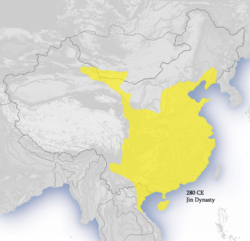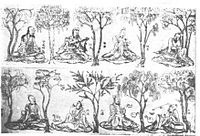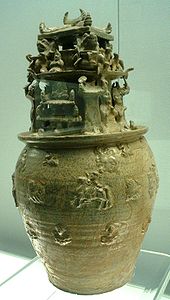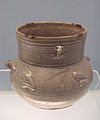- Jin Dynasty (265–420)
-
Jin Dynasty
晉朝← 
←
266 CE–420 CE  →
→
 →
→The Western Jin Dynasty (yellow) in 280 AD Capital Luoyang (265–311)
Chang'an (312–316)
Jiankang (317–420)Language(s) Chinese Religion Buddhism, Daoism, Confucianism, Chinese folk religion Government Monarchy Emperor - 265–290 CE Emperor Wu of Jin - 419–420 CE Emperor Gong of Jin History - Establishment 266 CE - Reunification of China under Jin rule 280 - Jin evacuates to region south of the Huai River, Eastern Jin begins 317 - Abdication to Liu Song 420 CE Population - 290 est. 22,620,000 Currency Chinese coin, Cash The Jìn Dynasty (simplified Chinese: 晋朝; traditional Chinese: 晉朝; pinyin: Jìn Cháo; Wade–Giles: Chin⁴-ch'ao², IPA: [tɕîn tʂʰɑ̌ʊ];), was a dynasty in Chinese history, lasting between the years 265 and 420 AD. There are two main divisions in the history of the Dynasty, the first being Western Jin (ch: 西晉, 265–316) and the second Eastern Jin (ch: 東晉 317–420). Western Jin was founded by Sima Yan, with its capital at Luoyang, while Eastern Jin was begun by Sima Rui, with its capital at Jiankang. The two periods are also known as Liang Jin (ch: 兩晉 lit, two Jin) and Sima Jin by scholars, to distinguish this dynasty from other dynasties that use the same Chinese character, such as the Later Jin Dynasty (ch: 後晉).
Contents
Foundation
The Sima clan was initially subordinate to the Wei dynasty, but the clan's influence and power grew greatly after the incident at Gaoping tombs in 249. In 265, Sima Yan forced emperor Cao Huan of Wei to abdicate the throne to him, ending Wei and starting Jin (as Emperor Wu). He named his dynasty after the state of Jin of the Spring and Autumn Period that once ruled the Sima clan's home county of Wen in Henei (present day Wen County, Henan). In 280, the Jin conquered Eastern Wu and unified China, but internal conflicts, corruption, and political turmoil quickly weakened the dynasty, and the unification lasted only ten years. Upon the advent of the second Jin emperor, Emperor Hui, various imperial princes tried to grab power in the devastating War of the Eight Princes. The Wu Hu uprising followed, during which large numbers of refugees fled south while the north was occupied by various nomadic tribes. This marked the end of the Western Jin dynasty in 316 when the Jin court evacuated to the region south of the Huai River, and the beginning of the Eastern Jin and the Sixteen Kingdoms period.
Sima Rui founded the Eastern Jin at Jiankang in 317, with its territory stretching across most of today's southern China. The combination of the Eastern Jin and Sixteen Kingdoms period is sometimes called the Eastern Jin Sixteen Kingdoms (ch: 東晉十六國). During this period, huge numbers of people moved south from the central plain, stimulating the development of Southern China. The Emperors of Eastern Jin had limited power, with most of it concetrated in the royal family's hands, whilst military power was mostly wielded by non-royals. Many fangzhen (ch:方鎮 lit. military county) started to have ambitions which resulted in military revolts, like the rebellions of Wang Dun, Su Jun, and the dictatorship of Huan Wen. Even though there was the stated goal of getting back the "northern lost lands", paranoia within the royal family and a constant string of disruptions to the throne caused the loss of support of many officials. In 383, Former Qin mobilized its troops and intended to conquer Eastern Jin. Faced by the threat of invasion, many Jin officials cooperated hoping to repel the attack. After the battle of Fei river, Xie An, Xie Xuan, and other generals were able to push back the Qin's assault and seized back a huge amount of territory from their enemy. However, more internal political battles from different groups of officials followed Huan Xuan's usurpation of the throne. As civilian administration suffered, more revolts from Sun En, Lu Xun, and the declaration of a new kingdom called Western Shu by the militarist Qiao zong in Eastern Jin's Shu region. Ultimately, Liu Yu's rise ended major chaos and later he took the throne for himself, marking the ending of the Jin Dynasty and the start of the Liu Song Dynasty, and the Southern and Northern Dynasties period of Chinese history.
History
Main article: History of the Jin Dynasty (265-420)The Western Jìn Dynasty (ch: 西晉, 265–316) was founded by Emperor Wu, better known as Sima Yan. Although it provided a brief period of unity after conquering Eastern Wu in 280, the Jìn suffered a devastating civil war, War of the Eight Princes, after which they could not contain the revolt of nomadic tribes known as the Wu Hu. The capital, Luoyang was captured in 311, and Emperor Huai was captured. His successor, Emperor Min was also captured in Chang'an in 316.
The remnants of the Jìn court fled to the east and reestablished the government at Jiankang, near modern-day Nanjing, under a member of the royal family named the Prince of Langye. The prince was proclaimed Emperor Yuan of the Eastern Jìn Dynasty (ch: 東晉 317–420) when news of the fall of Chang'an reached the south. (The rival Wu Hu states in the north, which did not recognize the legitimacy of Jin, would sometimes refer to it as "Langye.")
Military crises, such as the rebellions of generals Wang Dun and Su Jun, plagued the Eastern Jìn throughout its 104 years of existence. Another general, Huan Wen died in 373 before he could attempt to usurp the throne. However, the Battle of Fei River turned out to be a major Jìn victory, due to the short-lived cooperation of Huan Chong, brother of Huan Wen, and Prime Minister Xie An. Later, Huan Xuan, son of Huan Wen, usurped the throne and changed the dynasty's name to Chu. He, in turn, was toppled by Liu Yu, who after reinstating Emperor An, ordered him strangled and installed his brother, Emperor Gong, in 419.
Emperor Gong abdicated in 420 in favor of Liu Yu, ushered in the Liu Song Dynasty the first of the Southern Dynasties. The Jin Dynasty thus came to an end.
Meanwhile, North China was ruled by the Sixteen Kingdoms, many of which were founded by the Wu Hu. The last of these, Northern Liang, was conquered by the Northern Wei Dynasty in 439, ushering in the Northern Dynasties period.
Jin ceramics
The Jin Dynasty is well known for the quality of its greenish celadon porcelain wares, which immediately followed the development of proto-celadon. Jar designs often incorporated animal, as well as Buddhist, figures.[1]
Examples of Yue ware are also known from the Jin Dynasty.[2]
-
Celadon lion-shaped Bixie, Western Jin period, 265-317 CE.
-
Celadon Lian bowl with Buddhist figures, Western Jin, 265-317 CE.
Figure
Sovereigns of Jìn Dynasty
History of China ANCIENT 3 Sovereigns and 5 Emperors Xia Dynasty 2100–1600 BC Shang Dynasty 1600–1046 BC Zhou Dynasty 1045–256 BC Western Zhou Eastern Zhou Spring and Autumn Period Warring States Period IMPERIAL Qin Dynasty 221 BC–206 BC Han Dynasty 206 BC–220 AD Western Han Xin Dynasty Eastern Han Three Kingdoms 220–280 Wei, Shu and Wu Jin Dynasty 265–420 Western Jin 16 Kingdoms
304–439Eastern Jin Southern and Northern Dynasties
420–589Sui Dynasty 581–618 Tang Dynasty 618–907 (Second Zhou 690–705) 5 Dynasties and
10 Kingdoms
907–960Liao Dynasty
907–1125Song Dynasty
960–1279Northern Song W. Xia Southern Song Jin Yuan Dynasty 1271–1368 Ming Dynasty 1368–1644 Qing Dynasty 1644–1911 MODERN Republic of China 1912–1949 People's Republic
of China
1949–presentRepublic of
China (Taiwan)
1949–presentRelated articlesPosthumous names Family name and given names Durations of reigns Era names and their according range of years Chinese convention: "Jìn" + posthumous name + "di" Western Jìn Dynasty 265–316 Wu Di Sima Yan 266–290 Hui Di Sima Zhong 290–307 - Yongxi May 17, 290 – February 15, 291
- Yongping February 16 – April 23, 291
- Yuankang April 24, 291 – February 6, 300
- Yongkang February 7, 300 – February 3, 301
- Yongning June 1, 301 – January 4, 303
- Taian January 5, 303 – February 21, 304
- Yongan February 22 – August 15, 304; December 25, 304 – February 3, 305
- Jianwu August 16 – December 24, 304
- Yongxing February 4, 305 – July 12, 306
- Guangxi July 13, 306 – February 19, 307
none Sima Lun 301 - Jianshi February 3 – June 1, 301
Huai Di Sima Chi 307 – 311 Min Di Sima Ye 313–316 Eastern Jìn Dynasty 317–420 Yuan Di Sima Rui 317–323 Ming Di Sima Shao 323–325 Cheng Di Sima Yan 325–342 Kang Di Sima Yue 342–344 Mu Di Sima Dan 344–361 Ai Di Sima Pi 361–365 Fei Di Sima Yi 365–372 *Taihe 365–372 Jianwen Di Sima Yu 372 Xiaowu Di Sima Yao 372–396 An Di Sima Dezong 396–419 Gong Di Sima Dewen 419–420 Notes
- ^ Shanghai Museum permanent exhibit
- ^ Guimet Museum permanent exhibit
Major events
See also
- Chinese sovereign
- Ge Hong
- List of tributaries of Imperial China
- Liu Song Dynasty
- Northern Dynasties
- Northern Wei Dynasty
- Romance of the Three Kingdoms
- Six dynasties
- Sixteen Kingdoms
- Southern Dynasties
References
- Gernet,Jacques (1990). Le monde chinois. Paris: Armand Colin.
External links
- Chinese History, the Jin Dynasty 晉
- Largest Jin Dynasty Tomb Discovered in NW China
- Early Imperial China: A Working Collection of Resources
- History of China: A good catalogue of info
Preceded by
Three KingdomsDynasties in Chinese history
265–420Succeeded by
Southern and Northern DynastiesWu Hu Era History Wu Hu uprising · Disaster of Yongjia · Shi Le's unification of North China · Wei-Jie war · Wei-Xianbei war · Fu Jian's unification of North China · Huan Wen's expeditions · Battle of Fei River · Liu Yu's expeditionsInvolved Key personalities Histories of the Era Categories:- Former monarchies of Asia
- Former countries in Asia
- Former empires
- States and territories established in 265
- Jin Dynasty
- Sixteen Kingdoms
- 265 establishments
- 420 disestablishments
-
Wikimedia Foundation. 2010.









